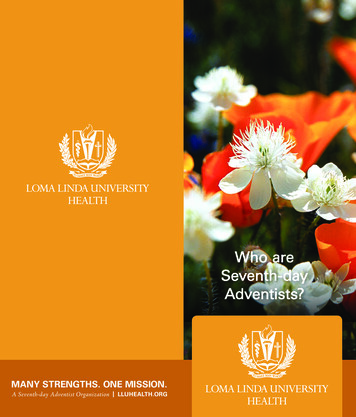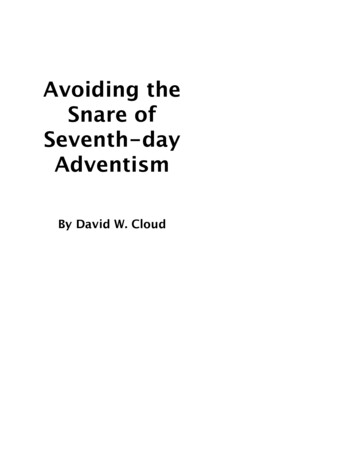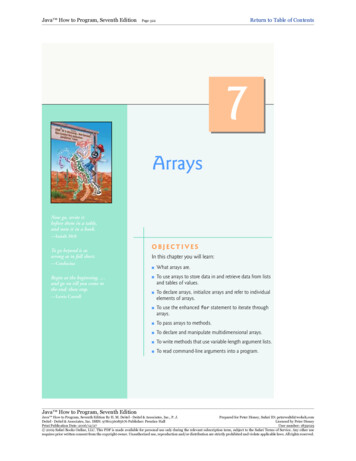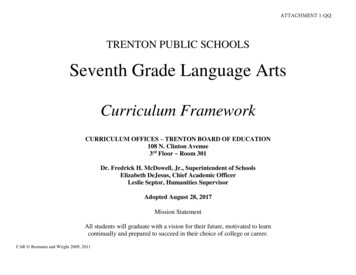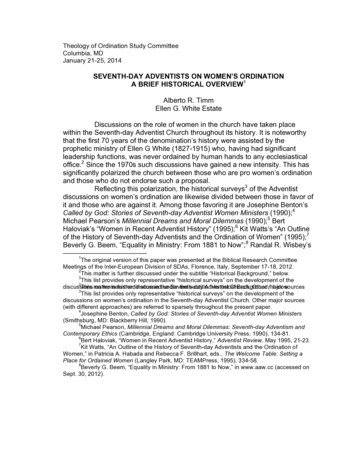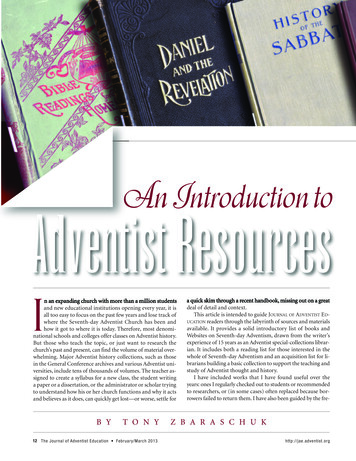
Transcription
National High Blood Pressure Education ProgramJNC 7 ExpressThe Seventh Reportof the Joint NationalCommittee onPrevention,Detection,Evaluation, andTreatment ofHigh Blood PressureU . S . D E P A R T M E N T O F H E A LT H A N D H U M A N S E R V I C E SNational Institutes of HealthNational Heart, Lung, and Blood Institute
JNC 7 ExpressThe Seventh Reportof the Joint NationalCommittee onPrevention,Detection,Evaluation, andTreatment ofHigh Blood PressureThis work was supported entirely by theNational Heart, Lung, and Blood Institute.The Executive Committee, writing teams,and reviewers served as volunteers withoutremuneration.U . S . D E PA RT M E N T O F H E A LT H A N D H U M A N S E RV I C E SNational Institutes of HealthNational Heart, Lung, and Blood InstituteNational High Blood Pressure Education ProgramNIH Publication No. 03-5233December 2003
ChairAram V. Chobanian, M.D. (Boston University Medical Center, Boston, MA)Executive CommitteeGeorge L. Bakris, M.D. (Rush Presbyterian-St. Luke’s Medical Center,Chicago, IL); Henry R. Black, M.D. (Rush Presbyterian-St. Luke’s MedicalCenter, Chicago, IL); William C. Cushman, M.D. (Veterans Affairs MedicalCenter, Memphis, TN); Lee A. Green, M.D., M.P.H. (University of Michigan,Ann Arbor, MI); Joseph L. Izzo, Jr., M.D. (State University of New York atBuffalo School of Medicine, Buffalo, NY); Daniel W. Jones, M.D. (Universityof Mississippi Medical Center, Jackson, MS); Barry J. Materson, M.D.,M.B.A. (University of Miami, Miami, FL); Suzanne Oparil, M.D. (Universityof Alabama at Birmingham, Birmingham, AL); Jackson T. Wright, Jr., M.D.,Ph.D. (Case Western Reserve University, Cleveland, OH)Executive SecretaryEdward J. Roccella, Ph.D., M.P.H. (National Heart, Lung, and BloodInstitute, Bethesda, MD)National High Blood Pressure Education ProgramCoordinating Committee ParticipantsClaude Lenfant, M.D., Chair (National Heart, Lung, and Blood Institute,Bethesda, MD); George L. Bakris, M.D. (Rush Presbyterian-St. Luke’sMedical Center, Chicago, IL); Henry R. Black, M.D. (Rush PresbyterianSt. Luke’s Medical Center, Chicago, IL); Vicki Burt, Sc.M., R.N. (NationalCenter for Health Statistics, Hyattsville, MD); Barry L. Carter, Pharm.D.(University of Iowa, Iowa City, IA); Jerome D. Cohen, M.D. (Saint LouisUniversity School of Medicine, St. Louis, MO); Pamela J. Colman, D.P.M.(American Podiatric Medical Association, Bethesda, MD); William C.Cushman, M.D. (Veterans Affairs Medical Center, Memphis, TN);Mark J. Cziraky, Pharm.D., F.A.H.A. (Health Core, Inc., Newark, DE);John J. Davis, P.A.-C. (American Academy of Physician Assistants, Memphis,TN); Keith Copelin Ferdinand, M.D., F.A.C.C. (Heartbeats Life Center, NewOrleans, LA); Ray W. Gifford, Jr., M.D., M.S. (Cleveland Clinic Foundation,Fountain Hills, AZ); Michael Glick, D.M.D. (UMDNJ—New Jersey DentalSchool, Newark, NJ); Lee A. Green, M.D., M.P.H. (University of Michigan,Ann Arbor, MI); Stephen Havas, M.D., M.P.H., M.S. (University of MarylandSchool of Medicine, Baltimore, MD); Thomas H. Hostetter, M.D. (NationalInstitute of Diabetes and Digestive and Kidney Diseases, Bethesda, MD);Joseph L. Izzo, Jr., M.D. (State University of New York at Buffalo School ofMedicine, Buffalo, NY); Daniel W. Jones, M.D. (University of MississippiMedical Center, Jackson, MS); Lynn Kirby, R.N., N.P., C.O.H.N.-S. (SanofiSynthelabo Research, Malvern, PA); Kathryn M. Kolasa, Ph.D., R.D., L.D.N.iii
(Brody School of Medicine at East Carolina University, Greenville, NC);Stuart Linas, M.D. (University of Colorado Health Sciences Center, Denver,CO); William M. Manger, M.D., Ph.D. (New York University MedicalCenter, New York, NY); Edwin C. Marshall, O.D., M.S., M.P.H. (IndianaUniversity School of Optometry, Bloomington, IN); Barry J. Materson, M.D.,M.B.A. (University of Miami, Miami, FL); Jay Merchant, M.H.A. (Centersfor Medicare & Medicaid Services, Washington, DC); Nancy Houston Miller,R.N., B.S.N. (Stanford University School of Medicine, Palo Alto, CA);Marvin Moser, M.D. (Yale University School of Medicine, Scarsdale, NY);William A. Nickey, D.O. (Philadelphia College of Osteopathic Medicine,Philadelphia, PA); Suzanne Oparil, M.D. (University of Alabama atBirmingham, Birmingham, AL); Otelio S. Randall, M.D., F.A.C.C. (HowardUniversity Hospital, Washington, DC); James W. Reed, M.D., F.A.C.P.,F.A.C.E. (Morehouse School of Medicine, Atlanta, GA); Edward J. Roccella,Ph.D., M.P.H. (National Heart, Lung, and Blood Institute, Bethesda, MD);Lee Shaughnessy (National Stroke Association, Englewood,CO);Sheldon G. Sheps, M.D. (Mayo Clinic, Rochester, MN); David B. Snyder,R.Ph., D.D.S. (Health Resources and Services Administration, Rockville,MD); James R. Sowers, M.D. (SUNY Health Science Center at Brooklyn,Brooklyn, NY); Leonard M. Steiner, M.S., O.D. (Eye Group, Oakhurst, NJ);Ronald Stout, M.D., M.P.H. (Procter and Gamble, Mason, OH);Rita D. Strickland, Ed.D., R.N. (New York Institute of Technology,Springfield Gardens, NY); Carlos Vallbona, M.D. (Baylor College ofMedicine, Houston, TX); Howard S. Weiss, M.D., M.P.H. (GeorgetownUniversity Medical Center, Washington Hospital Center, Walter Reed ArmyMedical Center, Washington, DC); Jack P. Whisnant, M.D. (Mayo Clinic andMayo Medical School, Rochester, MN); Laurie Willshire, M.P.H., R.N.(American Red Cross, Falls Church, VA); Gerald J. Wilson, M.A., M.B.A.(Citizens for Public Action on High Blood Pressure and Cholesterol, Inc.,Potomac, MD); Mary Winston, Ed.D., R.D. (American Heart Association,Dallas, TX); Jackson T. Wright, Jr., M.D., Ph.D., F. A.C.P. (Case WesternReserve University, Cleveland, OH)iv
ReviewersWilliam B. Applegate, M.D., M.P.H. (Wake Forest University School ofMedicine, Winston Salem, NC); Jan N. Basile, M.D., F.A.C.P. (VeteransAdministration Hospital, Charleston, SC); Robert Carey, M.D., (Universityof Virginia Health System, Charlottesville, VA); Victor Dzau, M.D. (Brighamand Women’s Hospital, Boston, MA); Brent M. Egan, M.D. (MedicalUniversity of South Carolina, Charleston, SC); Bonita Falkner, M.D.(Jefferson Medical College, Philadelphia, PA); John M. Flack, M.D., M.P.H.(Wayne State University School of Medicine, Detroit, MI); Edward D.Frohlich, M.D. (Ochsner Clinic Foundation, New Orleans, LA); HaralambosGavras, M.D. (Boston University School of Medicine, Boston, MA); MartinGrais, M.D. (Feinberg School of Medicine, Northwestern University, Chicago,IL); Willa A. Hsueh, M.D. (David Geffen School of Medicine, UCLADepartment of Medicine, Los Angeles, CA); Kenneth A. Jamerson, M.D.(University of Michigan Medical Center, Ann Arbor, MI); Norman M.Kaplan, M.D. (University of Texas Southwestern Medical Center, Dallas, TX);Theodore A. Kotchen, M.D. (Medical College of Wisconsin, Milwaukee, WI);Daniel Levy, M.D. (National Heart, Lung, and Blood Institute, Framingham,MA); Michael A. Moore, M.D. (Dan River Region Cardiovascular HealthInitiative Program, Danville, VA); Thomas J. Moore, M.D. (Boston UniversityMedical Center, Boston, MA); Vasilios Papademetriou, M.D., F.A.C.P.,F.A.C.C. (Veterans Affairs Medical Center, Washington, DC); Carl J. Pepine,M.D. (University of Florida, College of Medicine, Gainesville, FL); Robert A.Phillips, M.D., Ph.D. (New York University, Lenox Hill Hospital, New York,NY); Thomas G. Pickering, M.D., D.Phil. (Mount Sinai Medical Center,New York, NY); L. Michael Prisant, M.D., F.A.C.C., F.A.C.P. (MedicalCollege of Georgia, Augusta, GA); C. Venkata S. Ram, M.D. (Universityof Texas Southwestern Medical Center and Texas Blood Pressure Institute,Dallas, TX); Elijah Saunders, M.D., F.A.C.C., F.A.C.P. (University ofMaryland School of Medicine, Baltimore, MD); Stephen C. Textor, M.D.(Mayo Clinic, Rochester, MN); Donald G. Vidt, M.D. (Cleveland ClinicFoundation, Cleveland, OH); Myron H. Weinberger, M.D. (IndianaUniversity School of Medicine, Indianapolis, IN); Paul K. Whelton, M.D.,M.Sc. (Tulane University Health Sciences Center, New Orleans, LA)StaffJoanne Karimbakas, M.S., R.D. (Prospect Associates, Ltd., now part ofAmerican Institutes for Research Health Program, Silver Spring, MD)We appreciate the assistance of Carol Creech, M.I.L.S. and Gabrielle Gessner(Prospect Associates, Ltd., now part of American Institutes for ResearchHealth Program, Silver Spring, MD).v
The National High Blood Pressure Education Program (NHBPEP)Coordinating Committee Member OrganizationsAmerican Academy of Family PhysiciansAmerican Academy of NeurologyAmerican Academy of OphthalmologyAmerican Academy of Physician AssistantsAmerican Association of Occupational Health NursesAmerican College of CardiologyAmerican College of Chest PhysiciansAmerican College of Occupational and Environmental MedicineAmerican College of Physicians-American Society of Internal MedicineAmerican College of Preventive MedicineAmerican Dental AssociationAmerican Diabetes AssociationAmerican Dietetic AssociationAmerican Heart AssociationAmerican Hospital AssociationAmerican Medical AssociationAmerican Nurses AssociationAmerican Optometric AssociationAmerican Osteopathic AssociationAmerican Pharmaceutical AssociationAmerican Podiatric Medical AssociationAmerican Public Health AssociationAmerican Red CrossAmerican Society of Health-System PharmacistsAmerican Society of HypertensionAmerican Society of NephrologyAssociation of Black CardiologistsCitizens for Public Action on High Blood Pressure and Cholesterol, Inc.Hypertension Education Foundation, Inc.International Society on Hypertension in BlacksNational Black Nurses Association, Inc.National Hypertension Association, Inc.National Kidney Foundation, Inc.National Medical AssociationNational Optometric AssociationNational Stroke AssociationNHLBI Ad Hoc Committee on Minority PopulationsSociety for Nutrition EducationThe Society of Geriatric Cardiologyvi
Federal Agencies:Agency for Healthcare Research and QualityCenters for Medicare & Medicaid ServicesDepartment of Veterans AffairsHealth Resources and Services AdministrationNational Center for Health StatisticsNational Heart, Lung, and Blood InstituteNational Institute of Diabetes and Digestive and Kidney Diseasesvii
contentsPreface . . . . . . . . . . . . . . . . . . . . . . . . . . . . . . . . . . . . . . . . . . . . . . . . . . . . . . . . . . . . . . . . . . . . . . . . . . . . . . . . . . . . . . . . . . . . . . . . . . . . . . . . . . . . . . . . . . . . . . . . .xiAbstract . . . . . . . . . . . . . . . . . . . . . . . . . . . . . . . . . . . . . . . . . . . . . . . . . . . . . . . . . . . . . . . . . . . . . . . . . . . . . . . . . . . . . . . . . . . . . . . . . . . . . . . . . . . . . . . . . . . . . .xiiiIntroduction1.Methodology . . . . . . . . . . . . . . . . . . . . . . . . . . . . . . . . . . . . . . . . . . . . . . . . . . . . . . . . . . . . . . . . . . . . . . . . . . . . . . . . . . . . . . . . . . . . . . . . . . . . . . . . . . . . . . . . .1Classification of Blood Pressure . . . . . . . . . . . . . . . . . . . . . . . . . . . . . . . . . . . . . . . . . . . . . . . . . . . . . . . . . . . . . . . . . . . . . . . . . . . . . . . . .2Cardiovascular Disease Risk . . . . . . . . . . . . . . . . . . . . . . . . . . . . . . . . . . . . . . . . . . . . . . . . . . . . . . . . . . . . . . . . . . . . . . . . . . . . . . . . . . . . . . .2Benefits of Lowering Blood Pressure . . . . . . . . . . . . . . . . . . . . . . . . . . . . . . . . . . . . . . . . . . . . . . . . . . . . . . . . . . . . . . . . . . . . . . . . .3Blood Pressure Control Rates . . . . . . . . . . . . . . . . . . . . . . . . . . . . . . . . . . . . . . . . . . . . . . . . . . . . . . . . . . . . . . . . . . . . . . . . . . . . . . . . . . . . .4Accurate Blood Pressure Measurement in the Office . . . . . . . . . . . . . . . . . . . . . . . . . . . . . . . . . . . . . . . . . . . . . . .4Ambulatory Blood Pressure MonitoringSelf-Measurement of Blood Pressure5.5.Patient Evaluation . . . . . . . . . . . . . . . . . . . . . . . . . . . . . . . . . . . . . . . . . . . . . . . . . . . . . . . . . . . . . . . . . . . . . . . . . . . . . . . . . . . . . . . . . . . . . . . . . . . . . . . .5Laboratory Tests and Other Diagnostic Procedures . . . . . . . . . . . . . . . . . . . . . . . . . . . . . . . . . . . . . . . . . . . . . . . . . . .6Treatment . . . . . . . . . . . . . . . . . . . . . . . . . . . . . . . . . . . . . . . . . . . . . . . . . . . . . . . . . . . . . . . . . . . . . . . . . . . . . . . . . . . . . . . . . . . . . . . . . . . . . . . . . . . . . . . . . . . . . .7Goals of Therapy . . . . . . . . . . . . . . . . . . . . . . . . . . . . . . . . . . . . . . . . . . . . . . . . . . . . . . . . . . . . . . . . . . . . . . . . . . . . . . . . . . . . . . . . . . . . . . . . . . . . . . . . . . .7Lifestyle Modifications . . . . . . . . . . . . . . . . . . . . . . . . . . . . . . . . . . . . . . . . . . . . . . . . . . . . . . . . . . . . . . . . . . . . . . . . . . . . . . . . . . . . . . . . . . . . . . . . .7Pharmacologic Treatment . . . . . . . . . . . . . . . . . . . . . . . . . . . . . . . . . . . . . . . . . . . . . . . . . . . . . . . . . . . . . . . . . . . . . . . . . . . . . . . . . . . . . . . . . . . . .7Achieving Blood Pressure Control in Individual Patients . . . . . . . . . . . . . . . . . . . . . . . . . . . . . . . . . . . . . . . . .13Followup and Monitoring . . . . . . . . . . . . . . . . . . . . . . . . . . . . . . . . . . . . . . . . . . . . . . . . . . . . . . . . . . . . . . . . . . . . . . . . . . . . . . . . . . . . . . . . . . . .14Special Considerations . . . . . . . . . . . . . . . . . . . . . . . . . . . . . . . . . . . . . . . . . . . . . . . . . . . . . . . . . . . . . . . . . . . . . . . . . . . . . . . . . . . . . . . . . . . . . .14Compelling Indications . . . . . . . . . . . . . . . . . . . . . . . . . . . . . . . . . . . . . . . . . . . . . . . . . . . . . . . . . . . . . . . . . . . . . . . . . . . . . . . . . . . . . . . . . . . . . . .14Ischemic Heart Disease . . . . . . . . . . . . . . . . . . . . . . . . . . . . . . . . . . . . . . . . . . . . . . . . . . . . . . . . . . . . . . . . . . . . . . . . . . . . . . . . . . . . . . . . . . . . . .14Heart Failure . . . . . . . . . . . . . . . . . . . . . . . . . . . . . . . . . . . . . . . . . . . . . . . . . . . . . . . . . . . . . . . . . . . . . . . . . . . . . . . . . . . . . . . . . . . . . . . . . . . . . . . . . . . . . . . .15Diabetic Hypertension . . . . . . . . . . . . . . . . . . . . . . . . . . . . . . . . . . . . . . . . . . . . . . . . . . . . . . . . . . . . . . . . . . . . . . . . . . . . . . . . . . . . . . . . . . . . . . . .15Chronic Kidney Disease . . . . . . . . . . . . . . . . . . . . . . . . . . . . . . . . . . . . . . . . . . . . . . . . . . . . . . . . . . . . . . . . . . . . . . . . . . . . . . . . . . . . . . . . . . . . . .16Cerebrovascular Disease . . . . . . . . . . . . . . . . . . . . . . . . . . . . . . . . . . . . . . . . . . . . . . . . . . . . . . . . . . . . . . . . . . . . . . . . . . . . . . . . . . . . . . . . . . . .16ix
Other Special Situations . . . . . . . . . . . . . . . . . . . . . . . . . . . . . . . . . . . . . . . . . . . . . . . . . . . . . . . . . . . . . . . . . . . . . . . . . . . . . . . . . . . . . . . . . . . . .16Minorities . . . . . . . . . . . . . . . . . . . . . . . . . . . . . . . . . . . . . . . . . . . . . . . . . . . . . . . . . . . . . . . . . . . . . . . . . . . . . . . . . . . . . . . . . . . . . . . . . . . . . . . . . . . . .16Obesity and the metabolic syndrome . . . . . . . . . . . . . . . . . . . . . . . . . . . . . . . . . . . . . . . . . . . . . . . . . . . . . . . . . . . . . . . .16Left ventricular hypertrophy . . . . . . . . . . . . . . . . . . . . . . . . . . . . . . . . . . . . . . . . . . . . . . . . . . . . . . . . . . . . . . . . . . . . . . . . . . . . . . . .17Peripheral arterial disease . . . . . . . . . . . . . . . . . . . . . . . . . . . . . . . . . . . . . . . . . . . . . . . . . . . . . . . . . . . . . . . . . . . . . . . . . . . . . . . . . .17Hypertension in older persons . . . . . . . . . . . . . . . . . . . . . . . . . . . . . . . . . . . . . . . . . . . . . . . . . . . . . . . . . . . . . . . . . . . . . . . . . . . .17Postural hypotension . . . . . . . . . . . . . . . . . . . . . . . . . . . . . . . . . . . . . . . . . . . . . . . . . . . . . . . . . . . . . . . . . . . . . . . . . . . . . . . . . . . . . . . . . . .17Dementia . . . . . . . . . . . . . . . . . . . . . . . . . . . . . . . . . . . . . . . . . . . . . . . . . . . . . . . . . . . . . . . . . . . . . . . . . . . . . . . . . . . . . . . . . . . . . . . . . . . . . . . . . . . . . .17Hypertension in women . . . . . . . . . . . . . . . . . . . . . . . . . . . . . . . . . . . . . . . . . . . . . . . . . . . . . . . . . . . . . . . . . . . . . . . . . . . . . . . . . . . . . .18Hypertension in children and adolescents . . . . . . . . . . . . . . . . . . . . . . . . . . . . . . . . . . . . . . . . . . . . . . . . . . . . . . . . .18Hypertensive urgencies and emergencies . . . . . . . . . . . . . . . . . . . . . . . . . . . . . . . . . . . . . . . . . . . . . . . . . . . . . . . . .18Additional Considerations in Antihypertensive Drug Choices . . . . . . . . . . . . . . . . . . . . . . . . . . . . . . . . . .19Potential favorable effects . . . . . . . . . . . . . . . . . . . . . . . . . . . . . . . . . . . . . . . . . . . . . . . . . . . . . . . . . . . . . . . . . . . . . . . . . . . . . . . . . .19Potential unfavorable effects . . . . . . . . . . . . . . . . . . . . . . . . . . . . . . . . . . . . . . . . . . . . . . . . . . . . . . . . . . . . . . . . . . . . . . . . . . . . . .19Improving Hypertension Control . . . . . . . . . . . . . . . . . . . . . . . . . . . . . . . . . . . . . . . . . . . . . . . . . . . . . . . . . . . . . . . . . . . . . . . . . . . . . . .19Adherence to Regimens . . . . . . . . . . . . . . . . . . . . . . . . . . . . . . . . . . . . . . . . . . . . . . . . . . . . . . . . . . . . . . . . . . . . . . . . . . . . . . . . . . . . . . . . . . . . . .19Resistant Hypertension . . . . . . . . . . . . . . . . . . . . . . . . . . . . . . . . . . . . . . . . . . . . . . . . . . . . . . . . . . . . . . . . . . . . . . . . . . . . . . . . . . . . . . . . . . . . . .20Public Health Challenges and Community Programs . . . . . . . . . . . . . . . . . . . . . . . . . . . . . . . . . . . . . . . . . . . . .21Evidence Classification . . . . . . . . . . . . . . . . . . . . . . . . . . . . . . . . . . . . . . . . . . . . . . . . . . . . . . . . . . . . . . . . . . . . . . . . . . . . . . . . . . . . . . . . . . . . . .23Study Abbreviations25.Reference List . . . . . . . . . . . . . . . . . . . . . . . . . . . . . . . . . . . . . . . . . . . . . . . . . . . . . . . . . . . . . . . . . . . . . . . . . . . . . . . . . . . . . . . . . . . . . . . . . . . . . . . . . . . . .27x
p r e fac eSince the “Sixth Report of the Joint National Committee on the Prevention,Detection, Evaluation, and Treatment of High Blood Pressure (JNC 6)” wasreleased in 1997, new knowledge has come to light from a variety of sources.The National High Blood Pressure Education Program CoordinatingCommittee (NHBPEP CC), which represents 46 professional, voluntary, andFederal organizations, has periodically reviewed the emerging findings during itsbiannual meetings. Eventually, a critical mass of information accumulated thatgenerated much demand for a seventh report. My decision to appoint a JNC 7Committee was predicated on four reasons: (1) publication of many new hypertension observational studies and clinical trials; (2) need for a new, clear, andconcise guideline that would be useful for clinicians; (3) need to simplify theclassification of blood pressure; and (4) clear recognition that the JNC reportswere not being used to their maximum benefit.Dr. Aram Chobanian was selected as the JNC 7 chair because, like his predecessors, he is well versed in hypertension, yet independent of these major studies.The JNC 7 Executive Committee and writing teams were selected entirely fromthe NHBPEP CC because they are recognized as experts in their disciplines bytheir peers. Dr. Chobanian and his colleagues set—and met—a goal of completing and publishing this work in 5 months because of the urgency of applyingthe new information to improve hypertension prevention and treatment.This has been a remarkable accomplishment, but the task of NHBPEP CCnumbers is far from over. They and many others are now charged with disseminating the JNC 7 report, because none of this—neither the research studies northe recommendations—will matter, unless the JNC 7 is applied. To facilitate itsapplication, the JNC 7 will be produced in two versions. A “JNC 7 Express”has been developed for busy clinicians. A longer version to be published laterwill provide for a broader and more detailed review of the recommendations.Additional professional and patient education tools will support implementationof the JNC 7 recommendations.Dr. Chobanian has our deep appreciation for leading the JNC 7 Executive andCoordinating Committee members in developing this new report. I feel confident that this represents a landmark document and that its application willgreatly improve our ability to address a very important public health problem.Claude Lenfant, M.D.DirectorNational Heart, Lung, and Blood InstituteChairNational High Blood Pressure EducationProgramxi
abstractThe “Seventh Report of the Joint National Committee on Prevention,Detection, Evaluation, and Treatment of High Blood Pressure” provides anew guideline for hypertension prevention and management. The followingare the report’s key messages: In persons older than 50 years, systolic blood pressure greater than140 mmHg is a much more important cardiovascular disease (CVD) riskfactor than diastolic blood pressure. The risk of CVD beginning at 115/75 mmHg doubles with eachincrement of 20/10 mmHg; individuals who are normotensive at age55 have a 90 percent lifetime risk for developing hypertension. Individuals with a systolic blood pressure of 120–139 mmHg or adiastolic blood pressure of 80–89 mmHg should be considered asprehypertensive and require health-promoting lifestyle modificationsto prevent CVD. Thiazide-type diuretics should be used in drug treatment for mostpatients with uncomplicated hypertension, either alone or combined withdrugs from other classes. Certain high-risk conditions are compellingindications for the initial use of other antihypertensive drug classes(angiotensin converting enzyme inhibitors, angiotensin receptor blockers,beta-blockers, calcium channel blockers). Most patients with hypertension will require two or more antihypertensivemedications to achieve goal blood pressure ( 140/90 mmHg, or 130/80 mmHg for patients with diabetes or chronic kidney disease). If blood pressure is 20/10 mmHg above goal blood pressure, considerationshould be given to initiating therapy with two agents, one of which usuallyshould be a thiazide-type diuretic. The most effective therapy prescribed by the most careful clinician willcontrol hypertension only if patients are motivated. Motivation improveswhen patients have positive experiences with, and trust in, the clinician.Empathy builds trust and is a potent motivator. In presenting these guidelines, the committee recognizes that the responsiblephysician’s judgment remains paramount.xiii
introductionFor more than three decades, the National Heart, Lung, and Blood Institute(NHLBI) has coordinated the National High Blood Pressure Education Program(NHBPEP), a coalition of 39 major professional, public, and voluntary organizations and seven Federal Agencies. One important function is to issue guidelines and advisories designed to increase awareness, prevention, treatment, andcontrol of hypertension (high blood pressure (BP)). Since the publication of the“Sixth Report of the Joint National Committee on the Prevention, Detection,Evaluation, and Treatment of High Blood Pressure (JNC 6)” released in 1997,1many large-scale clinical trials have been published. The decision to appoint aJNC 7 committee was based on four factors: (1) publication of many newhypertension observational studies and clinical trials; (2) need for a new, clear,and concise guideline that would be useful for clinicians; (3) need to simplify theclassification of blood pressure; and (4) clear recognition that the JNC reportswere not being used to their maximum benefit. This JNC report is presented intwo separate publications: a current, succinct, practical guide and a more comprehensive report to be published separately, which will provide a broader discussion and justification for the current recommendations. In presenting theseguidelines, the committee recognizes that the responsible physician’s judgment isparamount in managing patients.m et h o d o lo g ySince the publication of the JNC 6 report, the NHBPEP CoordinatingCommittee (CC), chaired by the director of the NHLBI, has regularly reviewedand discussed the hypertension clinical trials at its biannual meetings. In manyinstances, the principal investigator of the larger studies has presented theinformation directly to the CC. The committee’s presentations and reviews aresummarized and posted on the NHLBI Web site.2 In agreeing to commission anew report, the Director requested that the CC members provide in writing adetailed rationale explaining the necessity to update the guidelines and todescribe the critical issues and concepts to be considered for a new report.The JNC 7 chair was selected, plus a nine-member Executive Committeeappointed entirely from the NHBPEP CC membership. The NHBPEP CCserved as members of five writing teams, each of which was cochaired by twoExecutive Committee members. The concepts identified by the NHBPEP CCmembership were used to develop the report outline. A timeline was developed to complete and publish the work in 5 months. Based on the identifiedcritical issues and concepts, the Executive Committee identified relevantMedical Subject Headings (MeSH) terms and keywords to further review the1
scientific literature. These MeSH terms were used to generate MEDLINEsearches that focused on English language peer-reviewed scientific literaturefrom January 1997 through April 2003. Various systems of grading the evidence were considered, and the classification scheme used in the JNC 6 reportand other NHBPEP clinical guidelines was selected3,4 which classifies studies ina process adapted from Last and Abramson.5 The Executive Committee meton six occasions, two of which included meetings with the entire NHBPEPCC. The writing teams also met by teleconference and used electronic communications to develop the report. Twenty-four drafts were created andreviewed in a reiterative fashion. At its meetings, the Executive Committeeused a modified nominal group process to identify and resolve issues. TheNHBPEP CC reviewed the penultimate draft and provided written commentsto the Executive Committee. In addition, 33 national hypertension leadersreviewed and commented on the document. The NHBPEP CC approved theJNC 7 report.c l a s s i f i c at i o n o f b loo d p r e s s u r eTable 1 provides a classification of BP for adults ages 18 and older. The classification is based on the average of two or more properly measured, seated BPreadings on each of two or more office visits. In contrast to the classificationprovided in the JNC 6 report, a new category designated prehypertension hasbeen added, and stages 2 and 3 hypertension have been combined. Patientswith prehypertension are at increased risk for progression to hypertension;those in the 130–139/80–89 mmHg BP range are at twice the risk to develophypertension as those with lower values.6cardiovascular disease riskHypertension affects approximately 50 million individuals in the United Statesand approximately 1 billion worldwide. As the population ages, the prevalenceof hypertension will increase even further unless broad and effective preventivemeasures are implemented. Recent data from the Framingham Heart Studysuggest that individuals who are normotensive at age 55 have a 90 percent lifetime risk for developing hypertension.7The relationship between BP and risk of CVD events is continuous, consistent,and independent of other risk factors. The higher the BP, the greater is thechance of heart attack, heart failure, stroke, and kidney disease. For individu2
Table 1. Classification and management of blood pressure for adults*Initial drug therapyWith CompellingDBP*LifestyleWithout n(See Table 8) 120120–139and 80or 80–89EncourageYesStage 1Hypertension140–159or 90–99Stage 2Hypertension 160or 100BPClassificationNormalPrehypertensionSBP*No antihypertensivedrug indicated.Drug(s) for compellingindications.‡YesThiazide-type diureticsfor most. May considerACEI, ARB, BB, CCB,or combination.YesTwo-drug combinationfor most† (usuallythiazide-type diureticand ACEI or ARB or BBor CCB).Drug(s) for the compelling indications.‡Other antihypertensivedrugs (diuretics, ACEI,ARB, BB, CCB)as needed.DBP, diastolic blood pressure; SBP, systolic blood pressure.Drug abbreviations: ACEI, angiotensin converting enzyme inhibitor; ARB, angiotensin receptor blocker; BB, beta-blocker;CCB, calcium channel blocker.Treatment determined by highest BP category.Initial combined therapy should be used cautiously in those at risk for orthostatic hypotension.‡ Treat patients with chronic kidney disease or diabetes to BP goal of 130/80 mmHg.*†als 40–70 years of age, each increment of 20 mmHg in systolic BP (SBP) or10 mmHg in diastolic BP (DBP) doub
American Institutes for Research Health Program, Silver Spring, MD) We appreciate the assistance of Carol Creech, M.I.L.S. and Gabrielle Gessner (Prospect Associates, Ltd., now part of American Institutes for Research Health Program, Silver Spring, MD). v




